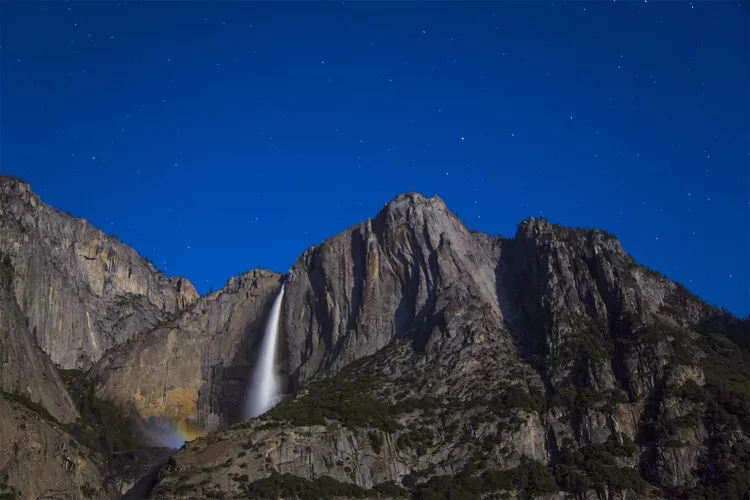Summary
Naturalist John Muir referred to them as Lunar Spraybows, and while some individuals may call them lunar rainbows, the most common term is “moonbow.” Regardless of the name, it represents an extraordinary phenomenon with a relatively simple explanation.
Daytime rainbows occur when sunlight interacts with water vapor in the air. Oftentimes at Yosemite Falls, this splendid sight can be observed in the mist generated at its base during the spring and early summer months.
A few times each year, moonlight and mist join forces to create a moonbow at Yosemite Falls during the night. However, achieving this phenomenon requires particular conditions: sufficient mist, optimal placement of the viewer, the moon’s position, clear dark skies, and bright moonlight. Moonbows at Yosemite typically appear in stretches lasting three to four days up to four times a year, predominantly in late spring and early summer. These natural spectacles are most vibrant when the moon is full, which usually occurs on the day it rises shortly after sunset.
Yosemite Falls Moonbow

The most common vantage points to observe a moonbow at Yosemite are near the base of Yosemite Falls, specifically from the viewing terrace at the west end of the bridge and from Cook’s Meadow near Sentinel Bridge. Nonetheless, it can also be sighted from various locations throughout Yosemite Valley that offer views of the falls.
However, do not expect to witness the vibrant colors as depicted in photographs. Once darkness sets in, the human eye loses the capacity to perceive the colors that a camera can capture. What you will likely see is a silvery-white glow instead.
This occurrence has garnered significant interest among photographers. On the night when the image was taken—which happened to be a Thursday evening in April—an estimated 150 photographers were concentrated in the area, their tripods and cameras poised to capture the moment.
If you’re interested in observing or photographing a Yosemite moonbow, consider checking moonbow date predictions for optimal timing.
Yosemite Falls in Spring

Water flow at Yosemite Falls varies annually, primarily due to the amount of snow melting in the high mountains. For example, 2010 was particularly exceptional, featuring a significant volume of water not seen for years. The roar of Yosemite Falls echoed throughout the valley, reminiscent of a locomotive passing by, and visitors could easily get wet even when standing some distance away.
Dry Yosemite Falls

Typically, peak runoff occurs in May or June, and by early autumn, the water flow may dwindle to just a trickle. Yosemite Creek, which is responsible for the falls, is an ephemeral stream like many other High Sierra waterways, only flowing temporarily following rainfall or snowmelt.
Viewed from the valley floor, Yosemite Falls appears to be two distinct waterfalls. Nonetheless, this perspective reveals that it is, in fact, a singular waterfall that takes a detour on its descent. The overall drop measures 2,425 feet, making it one of the tallest waterfalls worldwide.
Yosemite Falls Rainbow

The image captured the moment when the mist at the base of the upper fall coincided with sunlight to create a rainbow. In particularly wet years, Yosemite Creek may flow continuously; however, this much water in the photo was likely due to an early rainfall.
From a scientific perspective, the same natural principles govern the creation of both this rainbow and the moonbow discussed earlier; however, the visual effect differs significantly.
Frozen Yosemite Falls

During particularly cold winter mornings, the spray from Yosemite Falls may freeze until the sun rises. As the sun melts the ice, one can hear cracking sounds accompanied by segments of ice breaking off. Experienced visitors can often gauge the previous night’s temperatures based on the amount of ice observed alongside the Upper Fall in the morning: more ice indicates colder temperatures overnight.
Visitors might witness such a spectacle after following a winter storm into Yosemite Valley.
Although Yosemite Falls is the most renowned waterfall within the park, it is by no means the only one. In fact, several others have gained international acclaim. You can explore more about these magnificent waterfalls and their unique characteristics amidst the breathtaking backdrop of Yosemite National Park.





